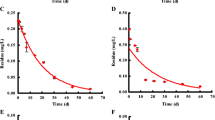Abstract
The dissipation and residues of bispyribac-sodium in rice cropping system were studied. Bispyribac-sodium residues were extracted by a simple analytical method based on QuEChERs and detected by LC-MS/MS. The limit of detection for bispyribac-sodium of this method was 0.375 × 10−3 ng. The limit of quantification (LOQ) was 5.0 μg/kg for rice plant samples, 2.0 μg/kg for rice hull, 0.2 μg/kg for water, and 0.1 μg/kg for soil and husked rice samples. The average recoveries of bispyribac-sodium ranged from 74.7 to 108 %, with relative standard deviations less than 13 %. The half-lives of bispyribac-sodium in rice plant, water, and soil were in the range of 1.4–5.6 days. More than 90 % of bispyribac-sodium residue dissipated within 5 days. The final residues of bispyribac-sodium in rice were all below LOQ at harvest time.



Similar content being viewed by others
References
Akoto, O., Andoh, H., Darko, G., Eshun, K., & Osei-Fosu, P. (2013). Health risk assessment of pesticides residue in maize and cowpea from Ejura, Ghana. Chemosphere, 92, 67–73.
Arnold, D. J., & Briggs, G. G. (1990). Fate of pesticides in soils: predictive and practical aspects. Environmental Fate of Pesticides, 101–202.
Cheng, H. H. (1990). Pesticides in the soil environment: process, impacts and modeling (p. 530). Madison: Soil Science Society of America. SSSA Book Series, No. 2.
Dhananjay, K. T., Vipin, K., Ravindranath, S. D., & Adarsh, S. (2005). Dissipation behavior of bifenthrin residues in tea and its brew. Food Control, 16, 231–237.
FAO. (2002). Submission and evaluation of pesticide residues data for the estimation of maximum residue level in food and feed. Rome: Food and Agriculture Organization of the United Nations.
Ferrero, A., Tesio, F., Tabacchi, M., & Vidotto, F. (2012). The effects of water management, timing and the rate of several herbicides on the growth of Murdannia keisak (Hassk.) Handel-Mazz. Crop Protection, 38, 53–56.
Fischer, A. J., Ateh, C. M., Bayer, D. E., & Hill, J. E. (2000a). Herbicide-resistant Echinochloa oryzoides and E. phyllopogon in California Oryza sativa fields. Weed Science, 48, 225.
Fischer, A. J., Bayer, D. E., & Carriere, M. D. (2000b). Mechanisms of resistance to bispyribac-sodium in an Echinochloa phyllopogon accession. Pesticide Biochemistry and Physiology, 68, 156–165.
Ge, K., Jia, J., & Liu, H. (2007). Food-based dietary guidelines in China practices and problems. Annals of Nutrition and Metabolism, 51(Suppl. 2), 26–31.
Hill, J. E., Le Strange, M. L., Bayer, D. E., & Williams, J. F. (1985). Integrated weed management in California. Proceedings Western Society of Weed Science, 38, 100.
Kasier, F. E. (1997). Liquid chromatographic method for the determination of Me2BA in Arkansas soil and water. ABC Laboratories, Inc. USA.
Kumar, V., Sood, C., Jaggi, S., Ravindranath, S. D., Bhardwaj, S. P., & Shanker, A. (2005). Dissipation behavior of propargite—an acaricide residues in soil, apple (Malus pumila) and tea (Camellia sinensis). Chemosphere, 58, 837–843.
Pateiro-Moure, M., Arias-Estévez, M., López-Periago, E., Martínez-Carballo, E., & Simal-Gándara, J. (2008). Occurrence and downslope mobilization of quaternary herbicide residues in vineyard-devoted soils. Bulletin of Environmental Contamination and Toxicology, 80, 407–411.
Acknowledgments
We are grateful for the support from the Chinese National Science Foundation, People’s Republic of China (project 31171872). We are also grateful for Guanxi Special Invited Scientist (2013) program in Agric-Environment and Agro-products Safety.
Author information
Authors and Affiliations
Corresponding author
Rights and permissions
About this article
Cite this article
Zhang, Q., Zhao, Y., Fan, S. et al. Dissipation and residues of bispyribac-sodium in rice and environment. Environ Monit Assess 185, 9743–9749 (2013). https://doi.org/10.1007/s10661-013-3287-z
Received:
Accepted:
Published:
Issue Date:
DOI: https://doi.org/10.1007/s10661-013-3287-z




